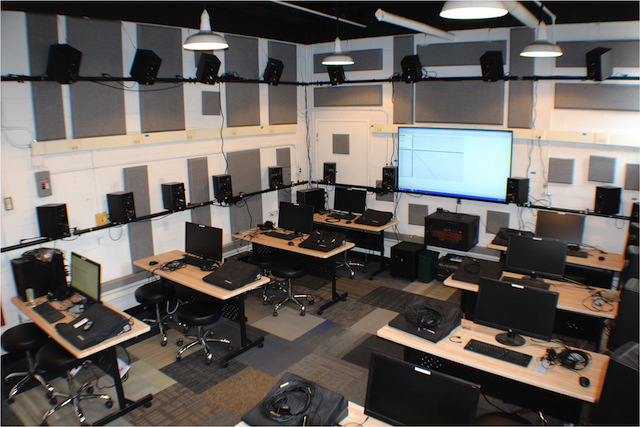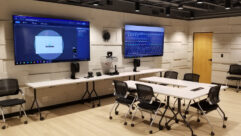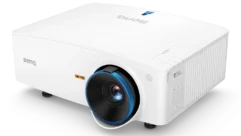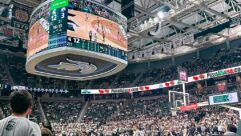

Blacksburg, VA—June 2018… Virginia Polytechnic Institute and State University, better known as Virginia Tech, is Virginia’s leading research institution, emphasizing collaborative education that integrates technology into all disciplines. Among the university’s most fascinating spaces are a state-of-the-art immersive performance and research space called the Cube, and a smaller experimental research facility called the Acoustics, Signal Processing, and Immersive-Reality (ASPIRe) Lab. Each venue offers a highly sophisticated, multi-speaker surround sound environment. In the latter space, the system’s many speakers connect to a Dante network using Attero Tech unD32 audio interfaces.
Located in the Moss Arts Center on campus, the Cube is a highly adaptable theater and lab that’s about 60 by 60 feet and 4 stories high. Shared between the Center for the Arts and the Institute for Creativity, Arts, and Technology (ICAT), and sometimes utilized by the School of Performing Arts, it serves the faculty, students, and guest artists and researchers, and is used for a wide variety of performances and experiential investigations. With 149 Dante-networked loudspeakers on the floor, ceiling, and walls; 360-degree cameras; Ambisonic microphones; and a 16-foot tall, 32-foot diameter, cylindrical projection screen called the Cyclorama, the Cube is an amazing space.
“Although we do both performances and research in the Cube, it’s in some ways not well suited for the sort of research I do,” cautions Professor of Mechanical Engineering Michael Roan. “It’s always filled with performances, so getting time in there is tough, and acoustically it’s not ideal for measuring human response to spatial sound, which is my thing. So I built ASPIRe here in Randolph Hall, where my office is. We do development at ASPIRe with 58 JBL LSR305 studio monitor speakers on a Dante network, driven by two Attero Tech unD32 interfaces. Then we go to the Cube, remap the speakers for the larger system, and do performances or studies down there. We also can bring projects from the Cube back to ASPIRe and essentially down-sample them spatially.”
Roan and his students use synthesis and localization tools to direct sounds where to appear and where to move in the Ambisonic soundfield. “We can take localization cues from sound we’ve recorded live and we also can synthesize the localization cues,” Roan explains. “For example with DJs who just have stereo outs, we synthesize the surround locations. Many other artists create specific content for the system. ASPIRe has 10 workstations that connect via Dante Virtual Soundcard. Everything is computer based, mostly using MAX MSP, and digital audio goes out from a Mac Pro to various Dante-enabled devices.”

Because the ASPIRe system uses Dante networking, it required a Dante-enabled off ramp that had a lot of outputs. Unlike the Cube’s Dante system, though, the ASPIRe lab did not need a lot of inputs. “The Attero Tech unD32 was a perfect solution for what we needed,” Roan appraises. “Attero Tech equipment is very cost effective, and it provides all of the outputs we need. And the unD32s have been super reliable; they have worked flawlessly.”
Roan also teaches an audio engineering technology class at ASPIRe in which students learn to build the gear they would use to record, mix, and master. “They learn how to write DSP plug-ins, how to build loudspeaker enclosures with bass reflex and all the tuning that goes with that, how to build microphones and understand how the membrane in the condenser mic works, and so on,” he details. “The last third of the class is spatial audio, so they measure with SoundField mics and reproduce stuff in the lab, and then we do a final demo in the Cube. We’re going to create a graduate class that’s entirely about spatial audio.”
The ASPIRe lab is extremely versatile, allowing students to bring in additional equipment, such as a Neumann KU 100 dummy head for binaural work. But some of the lab’s gear must be handled with extreme caution. “I never let undergrads put their hands on the super expensive gear,” Roan admits. “But the equipment is entirely accessible through the network, so my grad students can set up experiments in a different laboratory, and they can run it all remotely in the ASPIRe lab without having to touch anything.”
One of the newest major ASPIRe efforts is a 64-channel wavefield synthesis project. “For the wavefield synthesis system, we’ll use 128 speakers, 3 inches apart,” explains Roan. “That creates real plane waves so there’s no sweet spot in the room. You don’t even have comb filtering; it creates perfect plane waves—if you do it right. But we can only feed 64 speakers from the Dante network with the two Attero Tech un32 interfaces we currently have, so we’ve ordered two more un32s. It’s a great solution for us.”
Roan’s classes have become so popular that his current lab can’t meet the demand. “This semester 45 students wanted in but I can only fit 20 people, so I’m looking for a bigger space,” he relates. “The students really enjoy it, and I really enjoy teaching it. It’s a lot of fun.”










